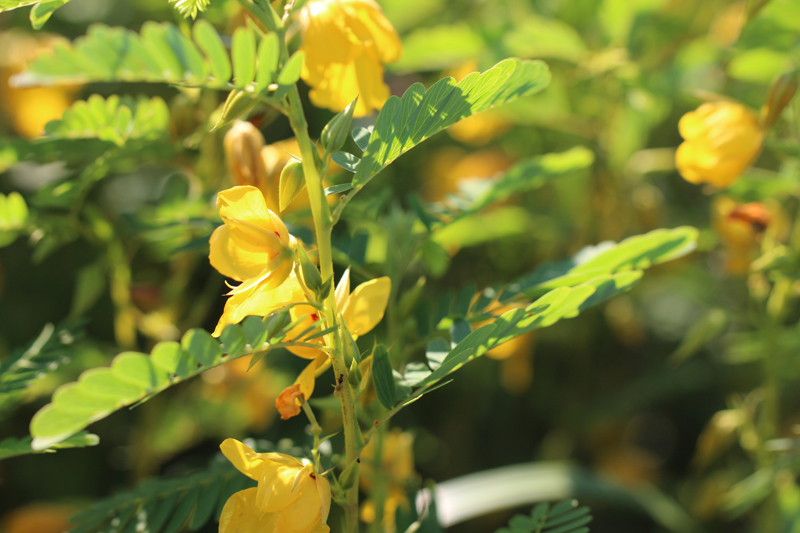
Partridge Pea
Chamaecrista fasciculata
Fabaceae


A cheerful ornamental wildflower with showy yellow and red flowers and delicate compound leaves which fold up slightly at night and when touched. Can bloom any time from June-October, produces long pea-like pods which spring open when ripe and dry, flinging their seeds up to three feet away, and grows very readily from seed. Tolerates drought, sand, acid soils, disturbed locations, and clay. Host plant to several species of butterflies, including the Cloudless Sulphur (Phoebis sennae), the Orange Sulphur (Colias eurytheme), and (one of our favorites here at Toadshade!) Sleepy Orange butterflies (Abaeis nicippe). The seeds are eaten by a number of seed-eating songbirds, an extraordinary number of game birds (hence the name Partridge Pea; these are actually a major winter food source for native Bobwhite Quails, but also feed Greater Prairie Chickens and waterfowl like Mallard Ducks), and small mammals such as chipmunks and field mice. This species is also a favorite of many types of pollinator, including butterflies and especially bumblebees and small native bees, both of which benefit particularly from this plant! Nectar is produced at the base of the leaves by small orange glands, and according to the Xerxes Society, this species may also attract predatory or parasitoid insects which prey upon pest insects, making it an ideal addition to most garden and meadow situations. Can be used extremely effectively for erosion control and reclaiming disturbed areas; like other members of the pea family, Partridge Pea has nodules on its roots to house nitrogen-fixing microorganisms, and can be grown in a relatively short-lived colony; when planted in a disturbed area, it will stabilize and enrich the soil with nitrogen, and then slowly die out, making way for non-pioneer species to move into the space. It can often be seen doing this naturally along riverbanks, where waterfowl gladly eat the seeds. Overall an extremely attractive, dainty little annual (occasionally short-lived perennial) with extremely high value to both gardeners and native wildlife. Also has a number of uses in traditional medicine of the Seminole and Cherokee tribes!


1-3 feet tall
Plant Hardiness Zones: 4a-11b
Annual
Native Range: MA south to FL, west to NM, and north to MN. Native to Canada in ON.
Germination - Easy: Heat soak overnight. Cover lightly
Partridge Pea in a 3.5 inch pot $13.75 (Temporarily Sold Out*)
Partridge Pea Seed Packet $5.00 (Temporarily Sold Out*)
*We normally carry this item but are temporarily sold out. We expect to have it available again as soon as our plants in production reach sufficient size/maturity or we harvest more seed. In some cases, plants may be recovering from caterpillar damage (Monarchs love our Milkweed), wind or hail damage, rampaging woodchucks, downed trees, or other natural issues. We are constantly updating our web site so please check back again.
Review or Finalize Your Order